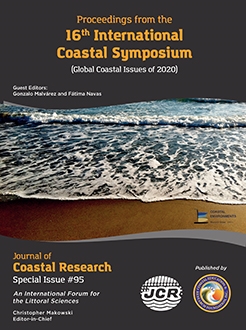Biausque, M. and Senechal, N., 2020. Analysis of two contrasting seasonal recovery periods of an open sandy beach, using high frequency DGPS surveys. In: Malvárez, G. and Navas, F. (eds.), Global Coastal Issues of 2020. Journal of Coastal Research, Special Issue No. 95, pp. 377-381. Coconut Creek (Florida), ISSN 0749-0208.
High frequency DGPS surveys were undertaken for 2.5 years (November 2015 until April 2018) on an open sandy double barred beach in the SW of France (Biscarrosse Beach) covering three winter and two summer periods. On those latitudes, summers are usually described as seasonal recovery periods. The morphological response of the beach during two consecutive summer periods (2016 and 2017) has been analyzed to identify processes involved in seasonal recovery. Analysis of alongshore mean profiles indicates that the summer 2016 is marked by a progressive berm reconstruction, manly driven by cross-shore sediment transport. The beach recovery in 2016 can be characterized as complete with a stable berm through the summer season associated with steady beach cusps, and a seaward dune foot migration. During this summer the variations in volume of each section of the beach (intertidal/supratidal beach and dune) show sediment transport firstly orientated from the intertidal beach toward the supratidal one, and, later, driven from the supratidal beach to the dune. This cycle is coherent with recent observations described by Philips (2017). In contrast, the summer 2017 is characterized by an incomplete recovery, an unstable berm and so, a much more complex dynamic: the berm, rapidly rebuild (by the end of June), started to erode in July. Six sequences of cross-shore sediment exchanges are measurable along the season between the intertidal and the supratidal beach, inducing successive erosion/ accretion of both sections of the beach. Thus, according to those results summers 2016 and 2017 present variable spatial and temporal dynamics. Moreover, analysis of hydrodynamic and environmental factors indicate that recovery periods not only depend on hydrodynamic conditions, such as wave energy and tide, but also on winter/summer morphological coupling, and sandbar/beach coupling.





